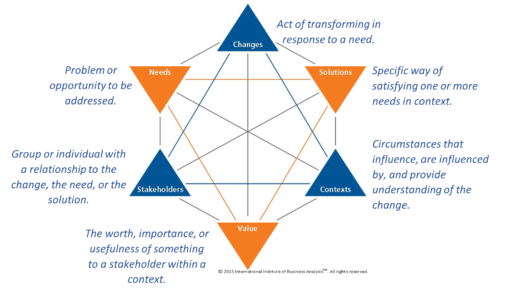One of the perhaps most frustrating aspects of studying for one of IIBA’s (International Institute of Business Analysis) core certification exams (ECBA™, CCBA®, CBAP®), is learning the lingo or terminology utilized within the practice framework. Remember, the BABOK® reflects an international framework created by BA thought leaders/professionals around the world so the terms are used “somewhere” by “someone!”
The purpose of this blog is to acquaint you with the structure of the Business Analysis Body of Knowledge (BABOK®) and reinforce the need to “get inside IIBA’s head” and see the world as IIBA sees the world of business analysis. Aligning with IIBA’s paradigm (which includes terminology) is key to studying for and passing the exam.
Business Analysts who are IIBA credential holders can successfully communicate with each other. For example, I asked a BA in Italy (the organization had off-shored some development work) about their risk approach regarding a high-impact risk that had been identified. That BA knew right away that I was asking for what you (or other frameworks) might call a “risk response strategy.” I queried another BA in India for which requirements attributes he thought it best to collect and he understood immediately that I was referring to 10 valuable pieces of information regarding requirements that IIBA offers for consideration. And, my personal pet peeve, is that many BAs refer to ALL requirements as “business requirements.” IIBA and PMI (Project Management Institute) agree on the FIVE categories of requirements (PMI throws in two more for good measure that are more project-oriented). As an IIBA credential holder, when I elicit “business requirements” I’m looking for business goals, objectives, and outcomes. I know that business requirements along with the “Need” (business problem or opportunity) become the BA’s “north star” in that it guides all business analysis activity.
Let’s first look at the structure of the BABOK® which is, by all accounts, a real page-turner. NOT! It’s really dry (as most frameworks are). I have students that attest that reading the BABOK® is their “go-to” cure for insomnia.
The BABOK has eleven chapters:
- Introduction
- Key Concepts
- Business Analysis Planning & Monitoring*
- Elicitation and Collaboration*
- Requirements Life Cycle Management*
- Strategy Analysis*
- Requirements Analysis and Design Definition*
- Solution Evaluation*
- Underlying Competencies
- Techniques
- Perspectives
*Knowledge Area (KA)
Each KA contains tasks and each task has (a):
- Purpose
- Description
- Inputs
- Elements
- Guidelines and Tools
- Techniques
- Stakeholders
- Outputs
By the way, there are 30 tasks.
What’s an “element” you ask? Great question! Elements are key concepts associated with the task; I personally call them “considerations.” They can be process steps, tools, characteristics of the task; in other words, “stuff to consider” when performing that task. Just to make things more fun, elements can belong to more than one task but mean different things given the specific task.
The BABOK® also defines 11 different types of stakeholders who the business analyst may engage while performing the tasks (Business Analyst, oddly enough, is one of the eleven!).
The entire content of the BABOK® is fair game for the exam (which is the focus of the next blog). In short, passing the CCBA® and CBAP® exams are dependent upon the test-taker’s ability to apply the knowledge to scenarios and case studies. It’s not enough to just regurgitate information; the emphasis is on applying the information. To that end, it’s important to understand the terminology so “words” don’t act as an impediment to and potentially threaten your success! Note: The ECBA™ exam is knowledge-based.
I want to take a moment and call out the Business Analysis Core Concept Model™ (BACCM™). The BACCM™ consists of six terms that have a common meaning to all business analysts (BAs). These concepts help BAs discuss business analysis approaches and activities in general in along with the relationships between the six concepts (using common terminology). The six concepts are listed below with their generic definitions; the definitions are “customized” for and within each Knowledge Area.

The BABOK® also differentiates between requirements and designs.
- A requirement is a “usable representation of a need.” Do you remember the definition of a “need?” See, you’re already connecting the dots!
- A design is a “usable representation of a solution” and focuses on understanding how value will be realized IF the solution is built. A design also helps the BA confirm and elicit more requirements.
Also worthy of note: There is only ONE “plan” that is listed as an output; typically, plans are called “approaches.”
As you can see, the BABOK® is jam-packed with the terminology the certification candidate will need to get under their belt! Language both reflects and shapes reality so understanding the terminology will help the exam candidate get into IIBA’s head!
The former principals of Watermark Learning, Elizabeth and Richard Larson, authored a desk reference entitled, “How to Talk BA” which is available from Watermark Learning and most other book distributors. That publication is great to have within arm’s reach for ready reference. Our certification prep course offerings and associated materials are written to demystify the BABOK® and help the exam candidate fluently “speak BA!” The CBAP Certification Study Guide and Study Tables (v 3.0 for both) are provided to students who participate in our CCBA/CBAP Certification Preparation course and are available for purchase through Watermark Learning and again, most other book distributors (Elizabeth and Richard Larson).
We at Watermark Learning look forward to “talking BA” with you soon!
You can contact us by phone (1-800-646-9362), email ([email protected]), or through our website (https://www.watermarklearning.com/contact.php).

 New Horizons
New Horizons
 Project Management Academy
Project Management Academy
 Six Sigma Online
Six Sigma Online
 Velopi
Velopi
 Watermark Learning
Watermark Learning
 Login
Login




 New Horizons
New Horizons
 Project Management Academy
Project Management Academy
 Velopi
Velopi
 Six Sigma Online
Six Sigma Online
 Watermark Learning
Watermark Learning